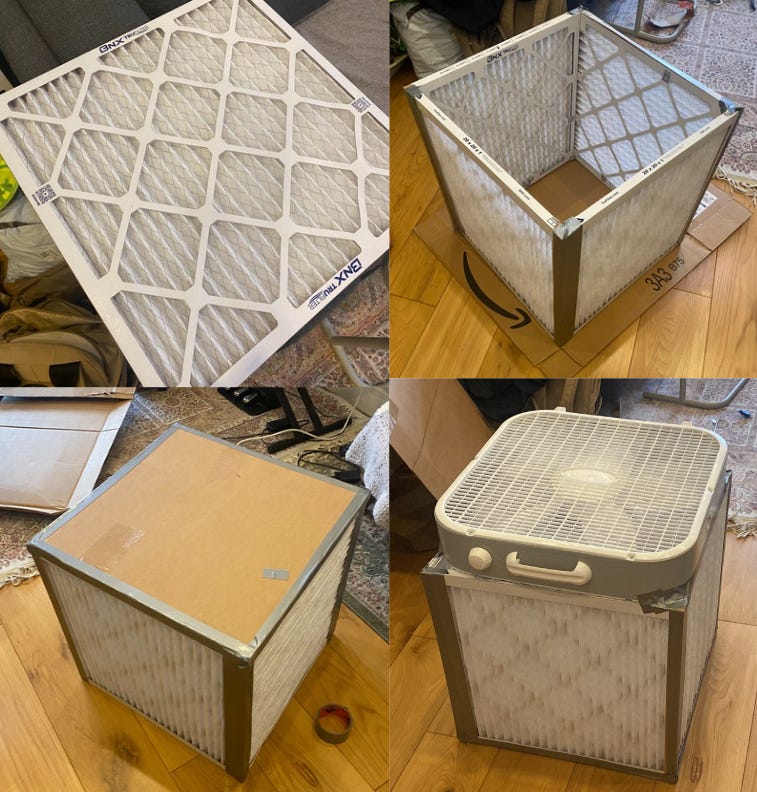I am trying to to test different air purifier designs.
I started by making a [Corsi-Rosthenthal](https://corsirosenthalfoundation.org/research/) box. These famous DIY air purifiers [seem pretty effective](https://corsirosenthalfoundation.org/research/), and are very cheap compared to commercial ones. There are many metrics (clean air delivery rate / PMx reduction / particle > x μm reduction) used to measure these, and many claims of efficacy. I’ll do a separate post on the literature, but for now the more conservative estimates put effectiveness at ~300 cubic feet per minute of clean air delivery. This is quite a bit better than air purifiers I’ve seen in the $150 - $200 range.
Because of all of the literature coming out, I wanted to jump in and test my own one. I also wanted to figure out how a layperson like me could test and verify that it works at home.
To make the box, I ordered 4 MERV-13 filters. A MERV 13 filter is [supposed to remove ≥50% of aerosol particles with a diameter of 0.3–1 μm, ≥85% of 1–3 μm particles, and ≥90% of 3–10 μm particles](https://pmc.ncbi.nlm.nih.gov/articles/PMC9759459/). I arranged them into a box and then taped the sides. Then I used the cardboard packaging to seal the bottom. After that, I put my 20’ box fan on top, air blowing upwards, and then used more tape to seal it to the box. The whole thing was pretty easy, and took around an hour to make. I did get slightly confused though with the arrangement of filters and direction of the fan, so be careful!
You can get the 20’ box fans for $25 on Ebay, and the four-pack of filters for $70 dollars. That being said, what made this quite expensive for me was the shipping into the UK (an extra $100). There is a UK version, however, that I want to test using this one as a control.
[

](https://substackcdn.com/image/fetch/$s_!JGLy!,f_auto,q_auto:good,fl_progressive:steep/https%3A%2F%2Fsubstack-post-media.s3.amazonaws.com%2Fpublic%2Fimages%2F60fcde88-0336-4fbd-b36f-aab8150d8850_757x792.png)
There is always the possibility of error with DIY stuff. So I want to figure out how someone could test to see if their DIY filter is working properly at home, with cheaper instruments and heuristics. My first thought is to generate some PM2.5 or other type of particle synthetically and then measure it with my m2000. I also want to look at measuring finer particles. It’s easy to measure PM2.5 and PM10 concentration, but the particle counters you need to more precise instruments are pretty expensive. The second-hand Kanomax particle counters start at around $800.
In terms of generating PM2.5 or other small particles I'm pretty torn, so I'm going to try make a a bunch of stuff and see what I get. I want to test making particles from sauteeing veg or frying with oil, nebulising salts, or making candle soot. [In my last post on frying and air quality](https://chillphysicsenjoyer.substack.com/p/frying-eggs-and-air-quality-tests), you guys suggested cooking with more oil, and with different ingredients. Thanks!
My goal it to test different types of DIY purifiers, and compare the strengths of each one into a simple heuristics document that people can understand. In particular, I want to see
- the difference with a ‘shroud’ and without a ‘shroud’ on the fan of the CR box.
- the difference between the UK and the US CR box versions - this is something I haven’t seen before online
- the difference compared to a ‘cocoon style’ purifier design with furniture battingø
- the difference compared to electric charge based purifiers.